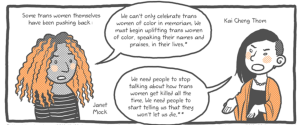Did you catch the Starbucks #RaceTogether campaign? It was an initiative to have baristas start conversations about race with customers, and it got a lot of attention for a hot minute (mostly comprised of opinions on why it was such a bad idea).
Then, before you could finish a latte, the campaign was over.
While it would be easy to toss it into the vault of unsuccessful racial justice ideas, that vault is pretty big, and it might get lost in there. Starbucks isn’t the first company to try to address race in the workplace, and they won’t be the last.
And that’s a good thing.
Workplace culture has a big impact on many of our lives, and the more we can shake up oppressive norms to cultivate work environments that are safe for everyone, the better.
So before we forget entirely about this campaign, let’s examine one of the goals behind it: fostering a supportive culture for its employees of color.
Apparently, Starbucks CEO Howard Schultz began the Race Together initiative after consultations with employees in the areas with the most active anti-police brutality protests. Since the baristas working for his company are 40% people of color, it’s promising to see him investing in facilitating racial justice.
Of course, however, plenty of people have pointed out why having baristas talk to strangers about race before they’ve had their morning coffee is not the best plan, regardless of good intentions.
So let’s take a step back and ask the question Schultz should have considered figuring out way before he began his campaign: What do you need to know to make a positive contribution to racial justice within your own business or organization?
First, we need to change both the overt and subtle ideas about race that harm people of color in the workplace.
Below are some of those toxic ideas and assumptions that creep into the workplace – with new perspectives that can help honor everyone’s humanity.
1. The Invisiblizing Assumption That One of Us Speaks for All of Us
I’m glad that Howard Schultz consulted with employees from multiple cities, rather than just one person of color hired to vouch for all things race-related (I dunno, ever since I heard about Justin Bieber’s swagger coach, I believe anything’s possible).
The common expectation is that people of color represent everyone of their race, and that is really unfair.
For one thing, people of color aren’t exempt from prejudice, and a single person’s perspective can lead you astray – especially if you choose someone whose ideas completely reflect and validate your own.
And further, no one person of color can speak for everyone else’s diverse and autonomous needs, so it’s an impossible expectation.
Tokenizing people of color dehumanizes us. Rather than treating us as representations of our race, we need our employers to support our individual needs. And our needs are definitely not all the same.
There are many ways tokenizing comes up in workplace culture, from hiring practices to insensitive questions.
As a result, people of color can feel othered, isolated, and misunderstood at work. Being tokenized affects our mental well-being and our sense of safety. As Robin M. Boylorn puts it at Crunk Feminist Collective, “You wonder how you can feel invisible and hypervisible at the same time.”
Already, we’re already struggling with high rates of unemployment. When we have to choose between the struggle of unemployment and the struggle of dehumanization, people of color can’t win.
Do you recognize any of this behavior at your workplace?
The solution is to treat everyone in a way that honors their unique individuality as one member of a non-monolithic group, to create a culture that welcomes all people for who they are as they are.
And please note: This does not mean saying such things as “I don’t see you as Black.”
2. Behaving Like Whiteness Is the Norm (And Everything Else Is ‘Other’)
Now, before you dismiss this one as something you could never actually believe, let me share some of the ways this message is reinforced in casual conversation.
“No, where are you really from?”
“Can I touch your hair?”
Sound familiar?
Even if you’ve never said these things, they’re pretty common statements, and you can help change the sentiment behind them.
Statements like these can seem harmless or even complimentary, but to a person of color who’s probably heard them their whole lives, they’re microaggressions that remind us that we’re seen as “different” – as in, abnormal.
And other people’s responses to our “differences” have usually lead to oppressive experiences like stereotypes, marginalization, fear, fetishization, and more.
Many of us have hurt and trauma around this stuff that we’re trying to heal from – and who wants to be retriggered over and over and over again just so that we can (sometimes) barely pay our bills?
For example, I’ve had my hair my whole life, so to me the texture is not all that mind-boggling. But my workplace hair stories range from coworkers touching it without permission to having to “figure out” something to do with it so I could look more like my (white) peers.
When you’re establishing a workplace culture, consider if your standards feel “normal” to everyone – or if some employees will have to conform to something that’s not remotely natural for them or be excluded all together.
And speaking of my hair, let’s talk about professionalism.
3. The Subtle and Blatant Beliefs That Being a Hard Worker Means Emulating Whiteness
You may think of dress codes as harmless. They’re just a way get everyone to look professional – as in, look like they know what they’re doing – right?
To create a work culture that supports everyone, we have to challenge common ideas about what it means to be “professional.”
As Carmen Rios wrote in “You Call It Professionalism; I Call It Oppression in a Three-Piece Suit” (an article I highly recommend), standards of professionalism “reinforce social hierarchies that value white maleness above all.”
For example, there are many workplaces where dreadlocks and afros are forbidden. I don’t know what they’re trying to say with that rule, but what I hear is that the way my hair grows naturally from my head is unprofessional.
Can you imagine the shame of being told that you don’t look “put together” because you look like yourself? That doesn’t make me feel like that workplace would look out for me.
These standards also uphold stereotypical ideas about who is and isn’t high-achieving, putting the pressure on people of color to work harder to prove ourselves, only to still be passed up for jobs and promotions.
Rethink what you believe to be “professional,” so that it doesn’t convey whiteness to be an indication of a person’s capacity to do their job.
4. The Fairy Tale Argument That We’re on a Level Playing Field
This is corporation speak for “I don’t see race.”
If you want to imagine your workplace as a post-racial utopia where you can treat everyone the same and therefore achieve equality, I have news for you: Race is relevant.
Race is relevant in the workplace, and a “colorblind” approach won’t work. Refusing to talk about race doesn’t make racism go away.
Race is relevant outside of the workplace. It also doesn’t work to approach it as if your workplace exists in a vacuum, without the context of historical and current injustice.
Have you ever wondered why someone at work was “so sensitive” about race? Ever thought someone calling for anti-racist policies was asking for “special treatment?”
Thoughts like these reflect a misunderstanding about racial justice. Respecting people of color in the workplace has to include recognizing the reality of what it means to be a person of color in the US.
As Jay Smooth said, these aren’t “issues that can be addressed by having chats in coffee shops. You’re talking about institutional, systemic issues,” not something that just manifests “on a personal level in our individual feelings toward each other.”
The monstrous nature of racial injustice shows that no single campaign will work to eradicate it – we need sustained, cultural change to take place.
And here’s the thing: You will make mistakes along the way. We all do, in all aspects of life and growing and change. But – and this is especially important when it comes to being an anti-racist ally – please don’t give up.
This is your chance to listen, own up to your mistakes, and use what you’ve learned to do better.
Trying to tackle the deep, complex, and sensitive issues of race is difficult work, and there’s no easy answer for how to get it right. But with an understanding of the oppression employees of color routinely face, you can make your best effort to support them in the workplace.
***
As much as I’m sure Howard Schultz would love for us to forget Race Together ever happened, let’s hold on to the memory a little longer. Not to shame him for making a mistake, but to remember what an effort on the scale of Race Together could accomplish.
There are plenty of ways to address racial issues on an interpersonal level, without engaging with undercaffeinated strangers.
Our own workplace culture is a great place to begin.
[do_widget id=”text-101″]
Maisha Z. Johnson is the Digital Content Associate and Staff Writer of Everyday Feminism. You can find her writing at the intersections and shamelessly indulging in her obsession with pop culture around the web. Maisha’s past work includes Community United Against Violence (CUAV), the nation’s oldest LGBTQ anti-violence organization, and Fired Up!, a program of California Coalition for Women Prisoners. Through her own project, Inkblot Arts, Maisha taps into the creative arts and digital media to amplify the voices of those often silenced. Like her on Facebook or follow her on Twitter @mzjwords.
Search our 3000+ articles!
Read our articles about:
Our online racial justice training
Used by hundreds of universities, non-profits, and businesses.
Click to learn more





















